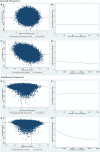Cost-effectiveness of single-layer versus double-layer uterine closure during caesarean section on postmenstrual spotting: economic evaluation alongside a randomised controlled trial
- PMID: 34215598
- PMCID: PMC8256741
- DOI: 10.1136/bmjopen-2020-044340
Cost-effectiveness of single-layer versus double-layer uterine closure during caesarean section on postmenstrual spotting: economic evaluation alongside a randomised controlled trial
Abstract
Objective: To evaluate the cost-effectiveness of double-layer compared with single-layer uterine closure after a first caesarean section (CS) from a societal and healthcare perspective.
Design: Economic evaluation alongside a multicentre, double-blind, randomised controlled trial.
Setting: 32 hospitals in the Netherlands, 2016-2018.
Participants: 2292 women ≥18 years undergoing a first CS were randomly assigned (1:1). Exclusion criteria were: inability for counselling, previous uterine surgery, known menstrual disorder, placenta increta or percreta, pregnant with three or more fetuses. 1144 women were assigned to single-layer and 1148 to double-layer closure. We included 1620 women with a menstrual cycle in the main analysis.
Interventions: Single-layer unlocked uterine closure and double-layer unlocked uterine closure with the second layer imbricating the first.
Main outcome measures: Spotting days, quality-adjusted life-years (QALYs), and societal costs at 9 months of follow-up. Missing data were imputed using multiple imputation.
Results: No significant differences were found between single-layer versus double-layer closure in mean spotting days (1.44 and 1.39 days; mean difference (md) -0.056, 95% CI -0.374 to 0.263), QALYs (0.663 and 0.658; md -0.005, 95% CI -0.015 to 0.005), total healthcare costs (€744 and €727; md €-17, 95% CI -273 to 143), and total societal costs (€5689 and €5927; md €238, 95% CI -624 to 1108). The probability of the intervention being cost-effective at willingness-to-pay of €0, €10 000 and €20 000/QALY gained was 0.30, 0.27 and 0.25, respectively, (societal perspective), and 0.55, 0.41 and 0.32, respectively, (healthcare perspective).
Conclusion: Double-layer uterine closure is not cost-effective compared with single-layer uterine closure from both perspectives. If this is confirmed by our long-term reproductive follow-up, we suggest to adjust uterine closure technique guidelines.
Trial registration number: NTR5480/NL5380.
Keywords: health economics; maternal medicine; obstetrics; ultrasonography.
© Author(s) (or their employer(s)) 2021. Re-use permitted under CC BY. Published by BMJ.
Conflict of interest statement
Competing interests: JH received grants from ZonMw, during the conduct of the study; and reports grants from Samsung, grants from PlantTec Medical, and received a fee from Olympus, all outside the submitted work. CdG received a grant from ZonMw outside the submitted work.
Figures


References
Publication types
MeSH terms
Associated data
LinkOut - more resources
Full Text Sources
Medical
